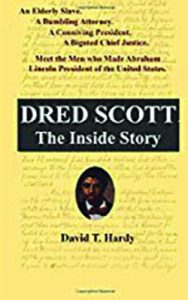By Joseph P. Tartaro | Executive Editor
 February, when this column is being written, is Black History Month. It seemed an appropriate time to review and comment on a new book, related to the dark days of slavery in America and the chicanery that was involved the pre-Civil War Supreme Court of the United States.
February, when this column is being written, is Black History Month. It seemed an appropriate time to review and comment on a new book, related to the dark days of slavery in America and the chicanery that was involved the pre-Civil War Supreme Court of the United States.
The book is DRED SCOTT: THE INSIDE STORY, by David T. Hardy. (©2019. 111 pages, soft cover. $9.95 Book, $4.99 Kindle edition from Amazon.com.)
The Dred Scott case involved much more than the question of the freedom and equal citizenship of elderly former slaves, Scott and his wife. Some say it led to the election of Abraham Lincoln and the bloody US Civil War when the Southern States seceded from the Union in order to preserve their dependence on a slave labor system and a cultural racial divide. There is no question that the high court’s decision is a dark spot in the high court’s history, which pretty much survived as law of the land for about 100 year.
I never understood how educated judges could come to the ruling that they did. And I was further confused years ago on a visit to the old federal court house in St. Louis where the case originated. Aside from the faded beauty of the old building near the banks of the Mississippi River, I was then surprised to learn that Scott’s case was a rare one in which the original lower federal originating court ruled in favor of Scott and at first assured their freedom from slavery.
Like probably many other Americans I wondered about the reversal of the circuit court’s decision.
For some 150 years people like me, commentators and historians have asked why did Scott’s attorneys sue John F. A. Sanford, a New York businessman hundreds of miles away, and why did Sanford stipulate to being Scott’s owner? Various theories have been proposed, and the most encyclopedic, Pulitzer-prize-winning, book on the subject concludes we’ll never know but should not say it was collusive unless someone finds hard evidence.
Now pro-gun attorney, author and videographer David T. Hardy has found the evidence: an eyewitness, a fellow who a century ago wrote of how he was in the room when the deal went down. When his uncle, John Sanford, agreed to pose as defendant to hide the role of the real slave owner, Sanford’s sister, and the identity of the other person to that bargain puts the case in a completely new light. It wasn’t a coincidence that the case went to the Supreme Court, and struck down the Missouri compromise. That was the plan from its very beginning, and Scott’s attorneys were suckered into it.
Conventional history: Scott’s suit started out in St. Louis, handled by local attorneys, and involving some narrow issues. At trial, the local attorneys disclaimed any attack on the Missouri Compromise. When the case got to the Supreme Court, the pro-slavery side brought in Reverdy Johnson, former Attorney General and the best Supreme Court advocate of the day, and he attacked the Missouri Compromise.
History as it must be rewritten: Johnson was in the case from the beginning. He was the one who recruited John Sanford as defendant, and the evidence is strong that he planned an attack on the Compromise that early, which suggests that Scott’s attorney was suckered into filing the suit, thinking it involved some narrow issues.
Hardy also found that pro-slavery President James Buchanan was in secret correspondence with justices of the Supreme Court, being advised of their deliberations, and in turn lobbying them to strike down the Missouri Compromise.
The Missouri Compromise was the legislation that provided for the admission of Maine to the United States as a free state along with Missouri as a slave state, thus maintaining the balance of power between North and South in the United States Senate. As part of the compromise, slavery was prohibited north of the 36°30′ parallel, excluding Missouri. The 16th United States Congress passed the legislation on March 3, 1820, and President James Monroe signed it on March 6, 1820.
Imagine an Eighteenth Century reality in which people could own other people (buying them with or without a warranty), or a person could buy himself, and become free, like indentured servants, another form of slavery. A reality in which slaves can sue their masters, and have a jury decide whether they are really free.
Into this not-alternate reality came a remarkable cast of Americans: Dred and Harriet Scott—the slaves whose suit for freedom sparked a battle in the Supreme Court and in the White House; John Sanford, the mountain man turned New York millionaire, who agreed to pose as the Scotts’ owner so the suit could be filed; Rep. Calvin Chaffee, the prominent Massachusetts abolitionist, who was shocked to discover that he and his wife owned slaves, indeed the most famous slaves in the United States; Roger Taney, chief justice of the Supreme Court, who tried to preserve the Union by protecting slavery, and instead brought on the Civil War and slavery’s abolition; James Buchanan, the President-elect who secretly connived with the Court’s pro-slavery justices, seeking a ruling that would let slavery spread throughout the territories; Abraham Lincoln, the failed frontier politician who awoke one morning to realize that Taney and Buchanan had given him the roadmap to the White House.
David Hardy, a New York Times best-selling author, explores the side of the Dred Scott case not explored in the history books, a side that involved mistakes, trickery, and skullduggery at the highest levels. You owe it to yourself as an American to read and understand what is still possible in the world of jurisprudence.



